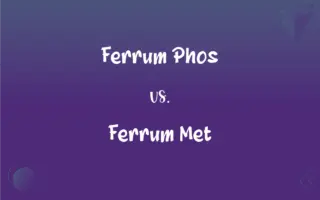Maltese vs. Bichon: What's the Difference?
Edited by Aimie Carlson || By Janet White || Published on March 5, 2024
Maltese and Bichon Frise are both small, white, fluffy dog breeds, but the Maltese has straight, silky hair, while the Bichon has curly, plush fur.

Key Differences
The Maltese and Bichon Frise are two popular breeds of small domestic dogs known for their friendly demeanor and distinctive coats. The Maltese breed is characterized by its long, silky, straight hair that falls to the ground if not trimmed. This breed has ancient origins, tracing back over 28 centuries, and was historically favored by aristocracy. On the other hand, the Bichon Frise features a soft, curly coat that gives it a puffball appearance, distinct from the Maltese's sleek and straight fur. The Bichon Frise, originating from the Mediterranean region, has a history of being a companion dog to sailors and later becoming a favorite in the French royal courts.
Both breeds are known for their playful and affectionate nature, making them excellent companions. The Maltese, with its gentle and fearless personality, thrives in a variety of living situations, making it suitable for apartment living. It is very loyal to its owners and can be somewhat reserved around strangers. The Bichon Frise is similarly adaptable and excels in social situations, often displaying a more outgoing personality compared to the Maltese. The Bichon is known for its cheerful disposition and ability to get along well with children and other pets.
In terms of health and lifespan, both breeds generally enjoy a long life expectancy, with the Maltese living around 12 to 15 years and the Bichon Frise similarly averaging 12 to 15 years. Both breeds are prone to certain health issues, with the Maltese susceptible to knee and dental problems, while the Bichon Frise may encounter skin and allergy-related issues.
Choosing between a Maltese and a Bichon Frise comes down to personal preference and lifestyle. Both breeds require a significant commitment to grooming and thrive on attention and companionship. Whether opting for the elegant Maltese or the cheerful Bichon Frise, owners are rewarded with a loyal and loving pet.
Comparison Chart
Coat Type
Long, silky, and straight
Soft, curly, and plush
ADVERTISEMENT
Origin
Ancient, with aristocratic roots
Mediterranean, favored by sailors and royalty
Personality
Gentle, fearless, somewhat reserved
Cheerful, outgoing, social
Grooming Needs
High; requires regular brushing
High; requires regular grooming to prevent matting
Hypoallergenic
No
Yes
Ideal Environment
Adaptable to various living situations
Thrives in social settings, good with families
ADVERTISEMENT
Health Issues
Prone to knee and dental problems
Prone to skin and allergy issues
Lifespan
Approximately 12 to 15 years
Approximately 12 to 15 years
Size
Small, with slightly varying weight and height
Small, but often sturdier than Maltese
Popularity
Highly favored for companionship
Known for its friendly nature and hypoallergenic coat
Maltese and Bichon Definitions
Maltese
The Maltese is an ancient breed, once favored by royalty.
The history of the Maltese fascinates me, especially its status as a royal companion.
Bichon
The Bichon Frise is a cheerful, small dog breed with a curly white coat.
The Bichon Frise played happily in the park, its white curls bouncing with each step.
Maltese
Maltese dogs are known for their gentle and affectionate nature.
Our Maltese greets everyone with friendly enthusiasm, making friends wherever she goes.
Bichon
Bichon Frises are hypoallergenic, making them suitable for allergy sufferers.
Our family chose a Bichon Frise because its hypoallergenic coat means no sneezing.
Maltese
Maltese thrive in various living situations, including apartments.
Living in a small apartment isn't an issue for our Maltese, who enjoys the cozy space.
Bichon
Regular grooming is essential for a Bichon Frise to prevent matting.
We schedule regular grooming appointments for our Bichon to keep his fur in perfect condition.
Maltese
The Maltese is a small, elegant dog breed with long, silky white hair.
The Maltese pranced gracefully at the dog show, its coat gleaming under the lights.
Bichon
Bichons are known for their playful and social personality.
Our Bichon loves doggy daycare, where he can socialize with other playful pups.
Maltese
The Maltese requires regular grooming to maintain its luxurious coat.
Grooming our Maltese has become a weekly ritual to keep his fur smooth and tangle-free.
Bichon
The Bichon Frise has a history of being a companion dog to sailors.
The Bichon's seafaring history is evident in its adventurous spirit and love for water.
Maltese
Of or relating to Malta or its people, language, or culture.
Bichon
A bichon frisé.
Bichon
Any of a class of toy dogs with curly or wavy hair and long curled tails.
Bichon
A Bichon Frisé.
FAQs
What's the main difference between a Maltese and a Bichon Frise?
The main difference is their coat; Maltese have long, straight hair, while Bichons have curly, plush fur.
Are Maltese good for allergy sufferers?
While Maltese are not hypoallergenic, their grooming routine can reduce allergens.
Can Maltese dogs live in apartments?
Yes, Maltese are adaptable and can thrive in apartment settings.
Is the Bichon Frise a hypoallergenic breed?
Yes, Bichons are considered hypoallergenic due to their coat that minimizes shedding.
Are Bichons good with children?
Bichons are known for their friendly nature and generally do well with children.
How often do Maltese need grooming?
Maltese require regular daily brushing and professional grooming every 4-6 weeks.
Are Bichons easy to train?
Bichons are intelligent and usually respond well to positive reinforcement training methods.
What activities do Bichons enjoy?
Bichons enjoy activities that involve interaction, such as playing fetch or participating in agility training.
Can Maltese be left alone for long periods?
Maltese can suffer from separation anxiety, so it's best not to leave them alone for extended periods.
What health issues are common in Bichons?
Bichons may be prone to skin and allergy issues, among other health concerns.
Do Maltese get along with other pets?
Maltese can get along with other pets if properly socialized from a young age.
What is the lifespan of a Maltese dog?
Maltese typically live around 12 to 15 years.
How does the Bichon Frise's personality differ from the Maltese?
Bichons tend to be more outgoing and sociable compared to the somewhat more reserved Maltese.
How much exercise does a Bichon Frise need?
Bichons are energetic and need daily exercise, but their needs can be met with short walks and playtime.
What makes the Maltese a preferred breed among aristocrats historically?
Their elegant appearance and gentle demeanor made them a favorite among aristocracy.
Are Maltese prone to any specific health problems?
Maltese may be susceptible to knee, dental, and eye issues.
Do Maltese bark a lot?
Maltese can be vocal, especially if they're alerting you to strangers or expressing their needs.
Is the Bichon Frise a good choice for first-time dog owners?
Yes, their friendly nature and manageable size make Bichons a good choice for first-time owners.
Can Bichon Frises adapt to cold weather?
Bichons can tolerate cold weather to an extent but should be protected from extreme conditions.
Which breed is better for a busy family, Maltese or Bichon?
Both can fit well, but the Bichon's sociable nature and hypoallergenic coat might be slightly more advantageous for busy families.
About Author
Written by
Janet WhiteJanet White has been an esteemed writer and blogger for Difference Wiki. Holding a Master's degree in Science and Medical Journalism from the prestigious Boston University, she has consistently demonstrated her expertise and passion for her field. When she's not immersed in her work, Janet relishes her time exercising, delving into a good book, and cherishing moments with friends and family.
Edited by
Aimie CarlsonAimie Carlson, holding a master's degree in English literature, is a fervent English language enthusiast. She lends her writing talents to Difference Wiki, a prominent website that specializes in comparisons, offering readers insightful analyses that both captivate and inform.







































































